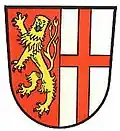Sayn-Wittgenstein-Vallendar
County of Sayn-Wittgenstein-Vallendar Grafschaft Sayn-Wittgenstein-Vallendar | |||||||||
|---|---|---|---|---|---|---|---|---|---|
| 1657–1775 | |||||||||
 Coat of arms
| |||||||||
| Status | State of the Holy Roman Empire | ||||||||
| Capital | Vallendar | ||||||||
| Government | Principality | ||||||||
| Historical era | Middle Ages | ||||||||
• Partitioned from S-W-Wittgenstein | 1657 | ||||||||
• Inherited by S-W-Hohnstein | 1775 | ||||||||
| |||||||||
Sayn-Wittgenstein-Vallendar was a County of the Holy Roman Empire. It was created as a partition of Sayn-Wittgenstein-Wittgenstein, and was inherited by Sayn-Wittgenstein-Hohenstein in 1775.[1][2]
Counts of Sayn-Wittgenstein-Vallendar (1657–1775)
- Friedrich Wilhelm (1657–1685|85)
- Johann Friedrich (1685–1718)
- Franz Friedrich Hugo (1718–1769)
- Johann Wilhelm (1718–1775)
References
- ^ Gottschalk, Friedrich. Genealogisches Taschenbuch für das Jahr. 1841 (in German). Walter de Gruyter GmbH & Co KG. ISBN 978-3-11-241290-9. Retrieved 26 November 2024.
- ^ https://sayn.de/familiengeschichte/